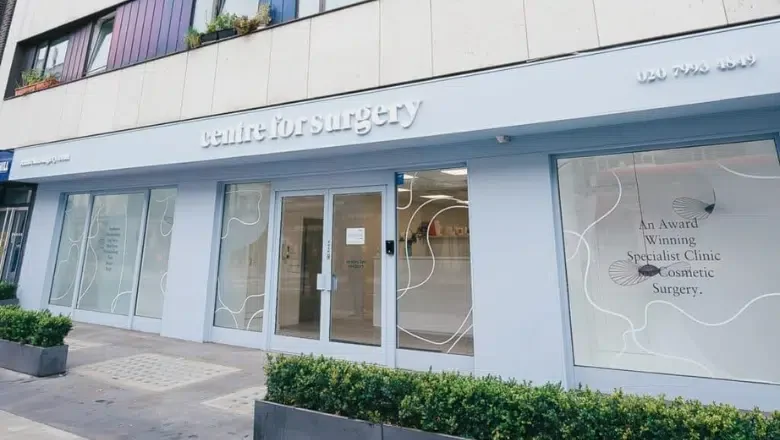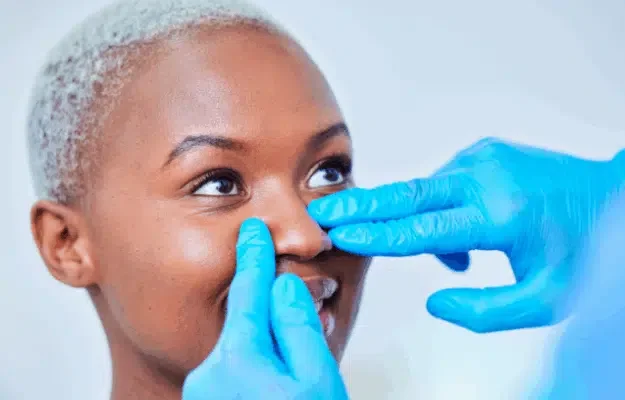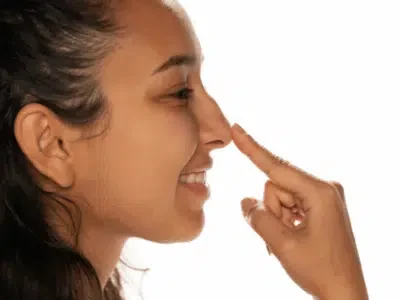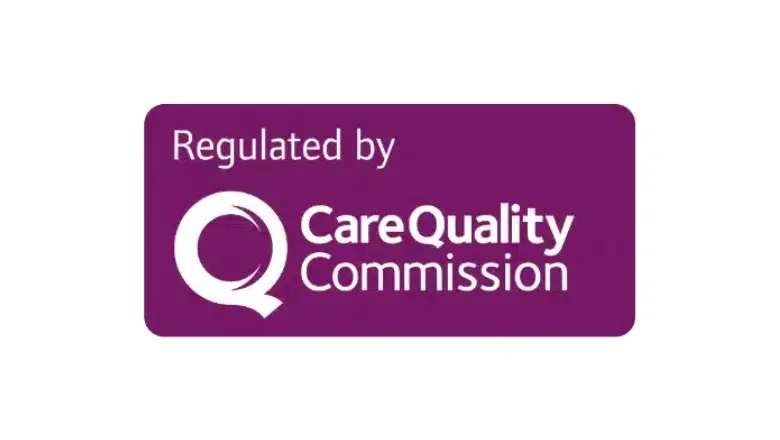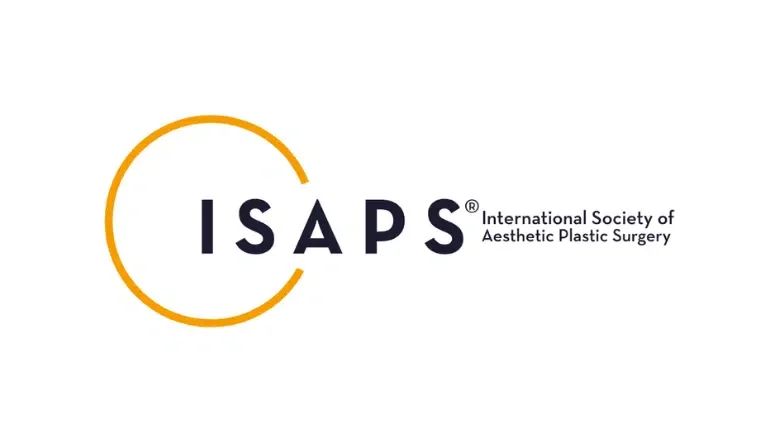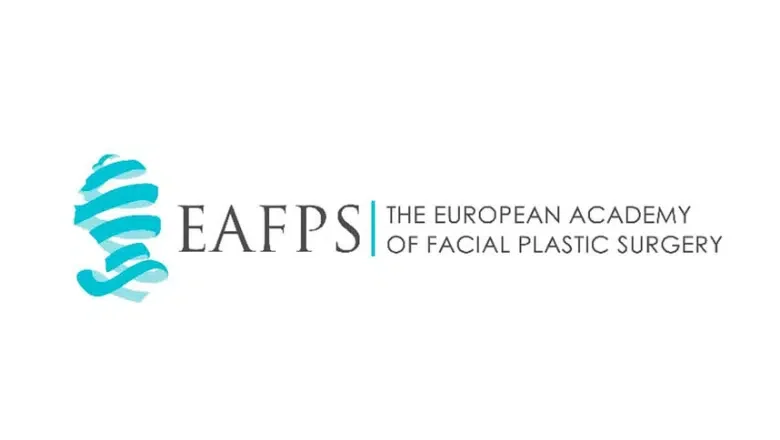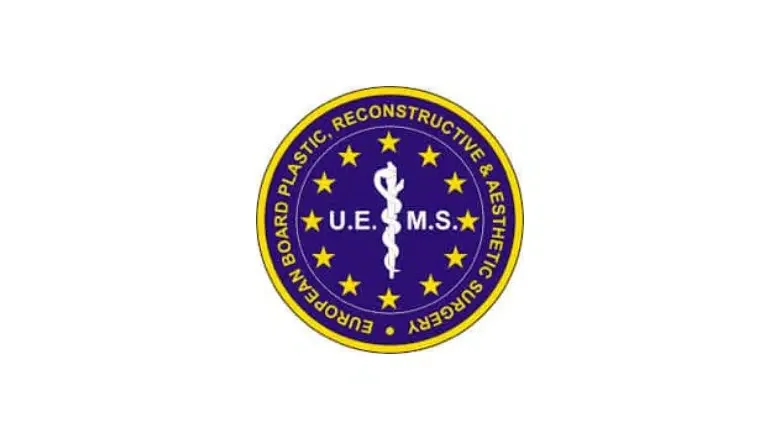Surgical Solutions for Tip Ptosis
A droopy nose, medically known as tip ptosis, can arise from several causes, one of the most common being genetics. If the tip of your nose naturally points downward, it’s likely a trait inherited from your family. Just as some individuals have noses where the tip curves upward, others are born with tips that naturally droop. The specific shape and orientation of your nasal tip are largely determined by the genetic characteristics passed down through generations.
RELATED: Different Types of Nose Shapes – What are the Surgical Options?
However, genetics isn’t the only factor that can lead to a drooping nose. Trauma is another significant cause. If you’ve ever experienced an injury to your nose—perhaps from playing sports, taking a fall, or being involved in an accident—the impact might have damaged the structures that support your nasal tip. Such injuries can weaken the attachments between the nasal cartilages. Over time, this weakening may cause the nose to droop as the supportive tissues gradually lose their strength and fail to hold the tip in its original position.
Ageing also plays a crucial role in the development of a droopy nose. As we grow older, it’s natural for the cartilage and connective tissues in our bodies to lose some of their elasticity and strength, and the nose is no exception. The cartilage attachments that keep the nasal tip in place can become looser and less resilient over the years. Even if you had a straight or upward-tilting nose in your younger days, you might notice that the tip has started to descend, giving your nose a more hooked appearance. This change is a common aspect of the ageing process and can affect anyone.
If you’re concerned about a drooping nose, whether due to genetics, injury, or ageing, there are solutions available. Centre for Surgery in London is a specialist clinic focused on plastic surgery, particularly rhinoplasty procedures. Our team of skilled surgeons regularly performs nose surgeries to address a wide range of nasal concerns, including tip ptosis. We understand that the appearance of your nose can significantly impact your self-confidence, and we’re committed to helping you achieve the look you desire through personalised surgical care.
How do you fix a droopy nose?
To address a droopy nose, known medically as tip ptosis, tip rhinoplasty is widely regarded as the most effective solution. This surgical procedure focuses on reshaping the nose to enhance both its function and appearance. During the operation, skilled surgeons carefully reposition the nasal cartilages, either returning them to their original location or adjusting them to a more aesthetically pleasing position that complements the patient’s facial features.
The process involves meticulous attention to detail. Surgeons may utilise cartilage grafts to provide additional support to the nasal structure. These grafts help reinforce the nose, ensuring that the repositioned cartilage remains stable and secure. In addition to grafts, specialised suture techniques are employed. These stitches are strategically placed to hold the cartilages in their new alignment, promoting proper healing and long-lasting results.
Rhinoplasty is a highly personalised procedure. It takes into account the unique anatomy of each patient’s nose and their individual aesthetic goals. By correcting the droop of the nasal tip, the surgery can restore balance to the face and boost self-confidence. The operation not only improves the nose’s appearance but can also enhance breathing function if structural issues are present.
Is Rhinoplasty for a Drooping Nose a Painful Experience?
The thought of undergoing surgery often brings concerns about pain and discomfort, especially when it involves the face. If you’re considering rhinoplasty to correct a drooping nose, you might be relieved to know that the procedure is generally not associated with significant pain. Most patients report experiencing more mild discomfort than actual pain in the days following the surgery.
RELATED: Is Rhinoplasty Painful?
In the initial phase after the operation, it’s common to feel some stuffiness or congestion inside the nose. This sensation arises from the natural swelling and healing processes taking place within the nasal tissues. The discomfort is often likened to the feeling of a heavy cold rather than sharp or intense pain. Over-the-counter pain relief is typically sufficient to manage any mild aches you might encounter.
The level of discomfort following rhinoplasty is usually much less than that associated with surgeries on other parts of the body, such as the abdomen. The nose is a smaller area with less extensive tissue manipulation required, which contributes to a smoother and more comfortable recovery period. Advances in surgical techniques have also made rhinoplasty less invasive, further reducing postoperative discomfort.
What Is the Recovery Period After Surgery for a Drooping Nose?
Undergoing surgery to correct a drooping nose—medically known as rhinoplasty for tip ptosis—is a significant decision that involves a careful recovery process. The healing period typically spans approximately seven to ten days, during which time you’ll need to follow specific aftercare instructions to ensure the best results.
RELATED: Nose Job Recovery Timeline – What to Expect
Immediately after the operation, your surgeon will place a custom-moulded splint over the bridge of your nose. This splint is designed to protect the nasal structures and maintain the new shape as it begins to heal. You’ll usually need to wear this external support for the first five days following the surgery. It might feel a bit unusual at first, but most patients adapt quickly to its presence.
In addition to the splint on the outside, internal sutures are used to secure the repositioned cartilage and tissues within your nose. These stitches are also in place for the initial five-day period. When you return to the clinic on the fifth day, the surgeon will gently remove the splint and assess how your nose is healing. This is often a moment patients look forward to, as the removal of the splint can make you feel significantly more comfortable.
After the splint comes off, the next phase involves taping the nose. From day five until day ten, medical tape is applied to support the nasal structures further and help reduce any swelling. While the tape is less bulky than the splint, it’s still visible, which is something to consider if you have social events or professional commitments during this time. If attending a formal occasion or important business meeting, you might feel self-conscious about the tape on your nose.
By the time you reach days seven to ten, most of the noticeable bruising and swelling should have subsided considerably. Everyone heals at their own pace, so some patients might see these signs diminish sooner, while for others it might take a little longer. Any remaining bruises or slight swelling can usually be easily concealed with a touch of makeup, allowing you to go about your daily activities with confidence.
Throughout your recovery, it’s important to follow the postoperative care instructions provided by your surgeon. Rest is essential in the first few days, but as you start to feel better—often soon after the splint is removed—you can gradually return to your normal routine. Just be mindful of avoiding strenuous activities or anything that might risk injuring your nose as it heals.
Regular follow-up appointments will be scheduled to monitor your progress and address any concerns you might have. Your surgeon and the medical team are there to support you every step of the way, ensuring that your healing is on track and that you’re happy with the results.
Why Choose Centre for Surgery?
Selecting the right surgical clinic is a pivotal step towards achieving your desired health and aesthetic goals. Centre for Surgery, located in London, is a specialist clinic renowned for its expertise in plastic surgery, particularly rhinoplasty procedures. Our team of highly qualified surgeons brings extensive experience and a commitment to excellence in every operation they perform, ensuring that you receive personalised care tailored to your individual needs.
At Centre for Surgery, patient well-being is at the heart of everything we do. Our modern facilities are equipped with cutting-edge medical technology, allowing us to provide the highest standard of surgical care in a safe and comfortable environment. We understand that undergoing surgery can be an anxious time, so we prioritise creating a supportive atmosphere where all your concerns are addressed with compassion and professionalism.
What sets us apart is our holistic approach to patient care. We combine advanced surgical techniques with an artistic sensibility to achieve natural-looking results that enhance your features and boost your confidence. From your initial consultation to your final follow-up appointment, our dedicated team is committed to guiding you through every step of your surgical journey with transparency and attentiveness.

